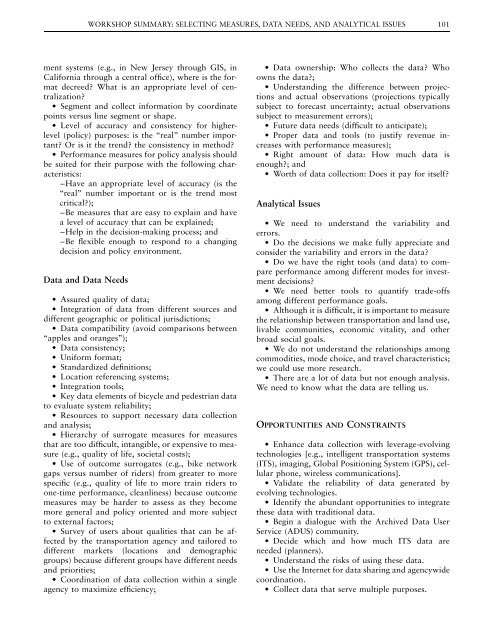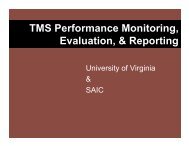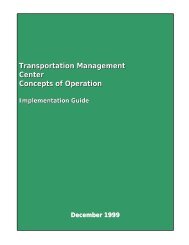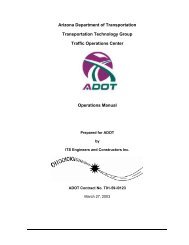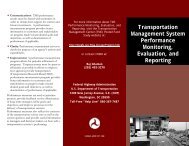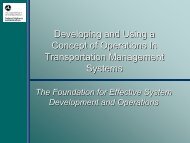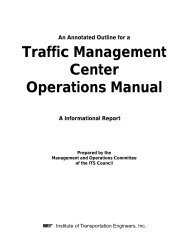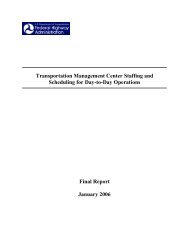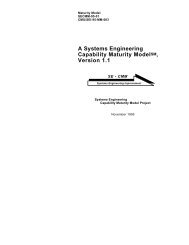Conference Proceedings 26 - Transportation Research Board
Conference Proceedings 26 - Transportation Research Board
Conference Proceedings 26 - Transportation Research Board
- No tags were found...
You also want an ePaper? Increase the reach of your titles
YUMPU automatically turns print PDFs into web optimized ePapers that Google loves.
WORKSHOP SUMMARY: SELECTING MEASURES, DATA NEEDS, AND ANALYTICAL ISSUES 101ment systems (e.g., in New Jersey through GIS, inCalifornia through a central office), where is the formatdecreed? What is an appropriate level of centralization?• Segment and collect information by coordinatepoints versus line segment or shape.• Level of accuracy and consistency for higherlevel(policy) purposes: is the ‘‘real’’ number important?Or is it the trend? the consistency in method?• Performance measures for policy analysis shouldbe suited for their purpose with the following characteristics:–Have an appropriate level of accuracy (is the‘‘real’’ number important or is the trend mostcritical?);–Be measures that are easy to explain and havea level of accuracy that can be explained;–Help in the decision-making process; and–Be flexible enough to respond to a changingdecision and policy environment.Data and Data Needs• Assured quality of data;• Integration of data from different sources anddifferent geographic or political jurisdictions;• Data compatibility (avoid comparisons between‘‘apples and oranges’’);• Data consistency;• Uniform format;• Standardized definitions;• Location referencing systems;• Integration tools;• Key data elements of bicycle and pedestrian datato evaluate system reliability;• Resources to support necessary data collectionand analysis;• Hierarchy of surrogate measures for measuresthat are too difficult, intangible, or expensive to measure(e.g., quality of life, societal costs);• Use of outcome surrogates (e.g., bike networkgaps versus number of riders) from greater to morespecific (e.g., quality of life to more train riders toone-time performance, cleanliness) because outcomemeasures may be harder to assess as they becomemore general and policy oriented and more subjectto external factors;• Survey of users about qualities that can be affectedby the transportation agency and tailored todifferent markets (locations and demographicgroups) because different groups have different needsand priorities;• Coordination of data collection within a singleagency to maximize efficiency;• Data ownership: Who collects the data? Whoowns the data?;• Understanding the difference between projectionsand actual observations (projections typicallysubject to forecast uncertainty; actual observationssubject to measurement errors);• Future data needs (difficult to anticipate);• Proper data and tools (to justify revenue increaseswith performance measures);• Right amount of data: How much data isenough?; and• Worth of data collection: Does it pay for itself?Analytical Issues• We need to understand the variability anderrors.• Do the decisions we make fully appreciate andconsider the variability and errors in the data?• Do we have the right tools (and data) to compareperformance among different modes for investmentdecisions?• We need better tools to quantify trade-offsamong different performance goals.• Although it is difficult, it is important to measurethe relationship between transportation and land use,livable communities, economic vitality, and otherbroad social goals.• We do not understand the relationships amongcommodities, mode choice, and travel characteristics;we could use more research.• There are a lot of data but not enough analysis.We need to know what the data are telling us.OPPORTUNITIES AND CONSTRAINTS• Enhance data collection with leverage-evolvingtechnologies [e.g., intelligent transportation systems(ITS), imaging, Global Positioning System (GPS), cellularphone, wireless communications].• Validate the reliability of data generated byevolving technologies.• Identify the abundant opportunities to integratethese data with traditional data.• Begin a dialogue with the Archived Data UserService (ADUS) community.• Decide which and how much ITS data areneeded (planners).• Understand the risks of using these data.• Use the Internet for data sharing and agencywidecoordination.• Collect data that serve multiple purposes.


